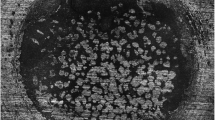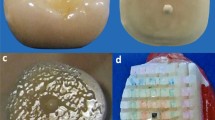Abstract
Aim
To compare the microshear bond strength of resin based composite (RBC) and resin modified glass ionomer cement (RMGIC) restorations when bonded to teeth with molar incisor hypomineralisation (MIH).
Methods
Eleven first permanent molars with MIH were included in this study. Teeth were sectioned mesio-distally producing a total of 22 surfaces for testing. Each specimen was placed inside a plastic ring with the flattened surface in contact with a glass slab. The plastic ring was filled with autopolymerising acrylic resin to imbed the specimen leaving the enamel surface exposed. Each surface was then bonded to 0.96 mm diameter RBC and light cured RMGIC following the manufacturers’ instructions. Microshear bond testing was performed after 24 h storage in distilled water at 37 °C. A Bisco shear tester was used to apply shear stress of 1 mm/min until failure. Wilcoxon signed-rank paired-test was used for comparison of bond strength values.
Results
Microshear bond strength of RBC (30.80 ± 8.19 MPa) was significantly higher than that of RMGIC (11.13 ± 6.91 MPa) when bonded to hypomineralised permanent first molars (p < 0.001).
Conclusion
The microshear bond strength of RBC is significantly higher than that of RMGIC when bonded to MIH affected teeth. Therefore, RBC can be recommended as the restoration of choice for teeth with MIH whenever the clinical scenario allows.

Similar content being viewed by others
References
Alaluusua S. Aetiology of Molar-Incisor hypomineralisation: a systematic review. Eur Arch Paediatr Dent. 2010;11(2):53–8.
Crombie F, Manton D, Kilpatrick N. Aetiology of molar–incisor hypomineralization: a critical review. Int J Paediatr Dent. 2009;19(2):73–83.
dos Santos MPA, Maia LC. Molar incisor hypomineralization: morphological, aetiological, epidemiological and clinical considerations. In: Li DM-Y, editor. Contemporary approach to dental caries. InTech; 2012.
Fagrell TG, Dietz W, Jalevik B, Noren JG. Chemical, mechanical and morphological properties of hypomineralized enamel of permanent first molars. Acta Odontol Scand. 2010;68(4):215–22.
Fayle SA. Molar incisor hypomineralisation: restorative management. Eur J Paediatr Dent. 2003;4(3):121–6.
Garg N, Jain AK, Saha S, Singh J. Essentiality of early diagnosis of molar incisor hypomineralization in children and review of its clinical presentation, etiology and management. Int J Paediatr Dent. 2012;5(3):190–6.
Kotsanos N, Kaklamanos EG, Arapostathis K. Treatment management of first permanent molars in children with Molar-Incisor hypomineralisation. Eur J Paediatr Dent. 2005;6(4):179–84.
Lygidakis NA. Treatment modalities in children with teeth affected by molar-incisor enamel hypomineralisation (MIH): a systematic review. Eur Arch Paediatr Dent. 2010;11(2):65–74.
Lygidakis NA, Chaliasou A, Siounas G. Evaluation of composite restorations in hypomineralised permanent molars: a four year clinical study. Eur J Paediatr Dent. 2003;4(3):143–8.
Lygidakis NA, Wong F, Jalevik et al. Best Clinical practice guidance for clinicians dealing with children presenting with Molar-Incisor-Hypomineralisation (MIH): An EAPD Policy Document. Eur Arch Paediatr Dent. 2010;11(2):75–81.
Mahoney EK. The treatment of localised hypoplastic and hypomineralised defects in first permanent molars. N Z Dent J. 2001;97(429):101–5.
McDonough WG, Antonucci JM, He J et al. A microshear test to measure bond strengths of dentin-polymer interfaces. Biomaterials. 2002;23(17):3603–8.
Mejare I, Bergman E, Grindefjord M. Hypomineralized molars and incisors of unknown origin: treatment outcome at age 18 years. Int J Paediatr Dent. 2005;15(1):20–8.
Phrukkanon S, Burrow MF, Tyas MJ. The influence of cross-sectional shape and surface area on the microtensile bond test. Dent Mater. 1998;14(3):212–21.
Sadashivamurthy P, Deshmukh S. Missing links of molar incisor hypomineralization: a review. J Int Oral Health. 2012;4(1):1–10.
Sano H, Shono T, Sonoda H et al. Relationship between surface area for adhesion and tensile bond strength–evaluation of a micro-tensile bond test. Dent Mater. 1994;10(4):236–40.
Wang H, Shimada Y, Tagami J. Shear bond stability of current adhesive systems to enamel. Oper Dent. 2004;29(2):168–75.
Watanabe L, Marshall G, Marshall S (eds.). Variables influence on shear bond strength testing to dentin. Advanced adhesive dentistry, 3rd International Kuraray Symposium, vol. Granada International Symposium. Kuraray Co. Ltd; 1999, pp 75–90.
Weerheijm KL. Molar incisor hypomineralization (MIH): clinical presentation, aetiology and management. Dent Update. 2004;31(1):9–12.
Weerheijm KL, Mejare I. Molar incisor hypomineralization: a questionnaire inventory of its occurrence in member countries of the European Academy of Paediatric Dentistry (EAPD). Int J Paediatr Dent. 2003;13(6):411–6.
Weerheijm KL, Jalevik B, Alaluusua S. Molar-incisor hypomineralisation. Caries Res. 2001;35(5):390–1.
Weerheijm KL, Duggal M, Mejare I et al. Judgement criteria for molar incisor hypomineralisation (MIH) in epidemiologic studies: a summary of the European meeting on MIH held in Athens, 2003. Eur J Paediatr Dent. 2003;4(3):110–3.
William V, Burrow MF, Palamara JE, Messer LB. Microshear bond strength of resin composite to teeth affected by molar hypomineralization using 2 adhesive systems. Pediatr Dent. 2006a;28(3):233–41.
William V, Messer LB, Burrow MF. Molar incisor hypomineralization: review and recommendations for clinical management. Pediatr Dent. 2006b;28(3):224–32.
Willmott NS, Bryan RA, Duggal MS. Molar-incisor-hypomineralisation: a literature review. Eur Arch Paediatr Dent. 2008;9(4):172–9.
Author information
Authors and Affiliations
Corresponding author
Rights and permissions
About this article
Cite this article
Arab, M., Al-Sarraf, E., Al-Shammari, M. et al. Microshear bond strength of different restorative materials to teeth with molar-incisor-hypomineralisation (MIH): a pilot study. Eur Arch Paediatr Dent 20, 47–51 (2019). https://doi.org/10.1007/s40368-018-0384-2
Received:
Accepted:
Published:
Issue Date:
DOI: https://doi.org/10.1007/s40368-018-0384-2




